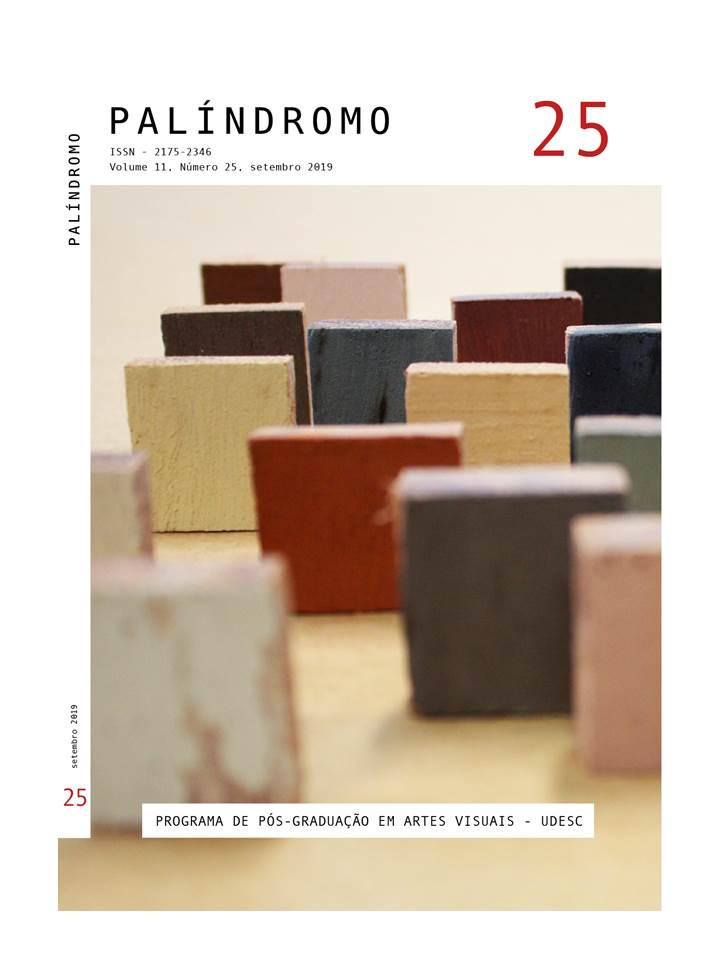POETIC NARRATIVES OF A PAINTING ATELIER AND ITS TRAINING CONTRIBUTION
DOI:
https://doi.org/10.5965/2175234611252019034Keywords:
poetical narratives, curriculum, 1336 painting studioAbstract
The present text is an analysis of the development and application of a curriculum of Visual Arts, as well as the creation of the 1336 painting studio that compose it and, ultimately, the development of the painting research of the three authors of the text located in this space. The purpose of the writing is to analyze the construction of this curriculum at the Universidade Federal de Santa Maria and its implications on the formative structure of 1336 painting studio. It seeks to investigate how space images produced poetic narratives and how its objects could affect the artistic production of the three authors of the text. Thus, the research describes that each one of the authors developed differently, but in the same space of meeting and sharing. As methodological subsidies used were: interview and documentary / bibliographic research. In this way, it is understood that the research on the formation of an individual and collective narrative shows how the images can be creation propulsion and formative contribution.
Downloads
References
ESNER, R., KISTERS, S., LEHMANN, A.S. (ed.). Hiding Making - Showing Creation.The Studio from Turner to TacitaDean. Amsterdam: University Press, 2013.
BASICO, S. P. Aportes para o diálogo sobre um novo currículo. Santa Maria: Imprensa Universitária UFSM, 1986.
BENETTI, A. Entrevista exclusiva concedida aos autores. Santa Maria, Brasil. Em 12 jun. 2017.
CALVO SERRALLER, Francisco. Los géneros de la pintura. Los géneros de la pintura. Madrid: Santillana Ediciones Generales, 2005.
CANTON, K. Natureza-Morta. In: Museu de Arte Contemporânea / SESI. Natureza--Morta: Still Life. São Paulo, 2004.
CHEREM, R. M. Imagem – acontecimento. In: FONSECA da SILVA, M. C. R.; MAKOWIE-CKY, S. (Org.). Linhas cruzadas: artes visuais em debate. Florianópolis: Ed. UDESC, 2009.
CIRILLO, J. Imagem – Lembrança: Comunicação e Memória no Processo de Criação. 2004. 160 p. Tese (Doutorado em Comunicação e Semiótica) – Universidade Católi-ca de São Paulo: São Paulo, 2004.
______, J; GRANDO, Ângela (org). Arqueologias da Criação: Estudos Sobre o Proces-so de Criação. Belo Horizonte: Com Arte, 2009.
COLI, J. O que é arte. São Paulo: Brasiliense, 2007.
SOUZA, E. C.; ABRAHÃO, M. H. M. B. Tempos, narrativas e ficções: a invenção de si. Porto Alegre: EDIPUCRS, 2006.
DIDI-HUBERMAN, G. O Rosto e a terra: onde começa o retrato, onde se ausenta o rosto.v. 9, n. 16.PortoAlegre:Porto Arte, 1998.
ENTLER, R. Testemunhos silenciosos: uma nova concepção de realismo na fotogra-fia contemporânea. São Paulo: ARS, 2006.
FREIRE, P. Pedagogia da autonomia: saberes necessários à prática educativa. 2ª im-pressão da 43ª edição. São Paulo: Paz e Terra, 2011.
LACROIX, L. “L’atelier-musée, paradoxe de l’expériencetotale de l’oeuvre d’art”. An-thropologie et Sociétés, XXX (3), 2006.
PASSERON, R. A poiética em questão. n. 21. v. 13. Instituto de Artes/ UFGRS. Porto Alegre: Porto Arte, 2004.
POLLAK, M. Memória e identidade social. Estudos históricos. v. 5, n. 10, p. 200-212, Rio de Janeiro: Editora FGV, 1992.
SCHNEIDER, N. Naturezas-Mortas. Lisboa:Taschen, 2009.
SOARES, C. Corpo e História. Campinas:Autores Associados, 2001.
TARKOVSKI, A. Esculpir o tempo. Trad. Jefferson Luiz Camargo. São Paulo: Martins Fontes, 1998.
Downloads
Published
How to Cite
Issue
Section
License
Copyright (c) 2019 Palíndromo

This work is licensed under a Creative Commons Attribution 4.0 International License.
COPYRIGHT STATEMENT
The articles published by the magazine are free to use, intended for academic and non-commercial applications. Copyright is all assigned to the magazine. The articles whose authors are identified represent the expression from the point of view of their authors and not the official position of Palíndromo Magazine. The author (s) commits to whenever they publish material referring to the article published in Palíndromo mention this publication as follows:
This article was originally published by Palíndromo magazine in its volume (place the volume), number (place the number) in the year of (place the year) and can be accessed at: http://www.revistas.udesc.br/index.php/palindromo


